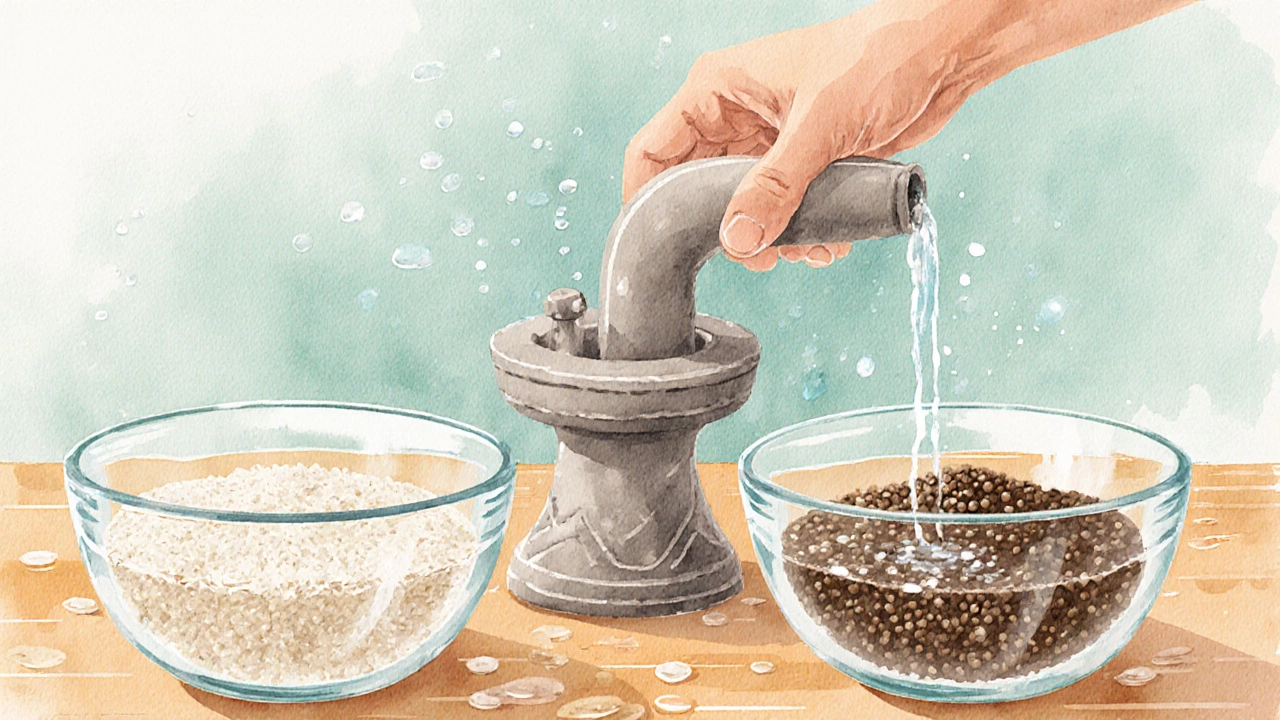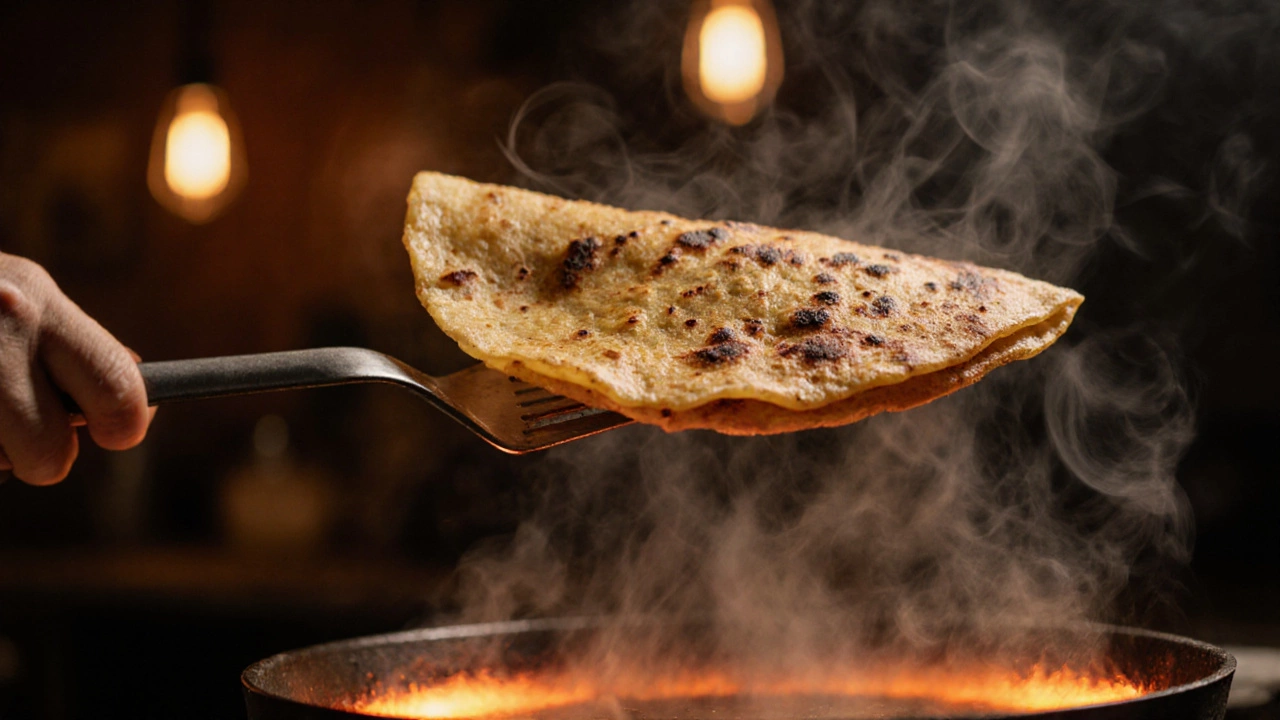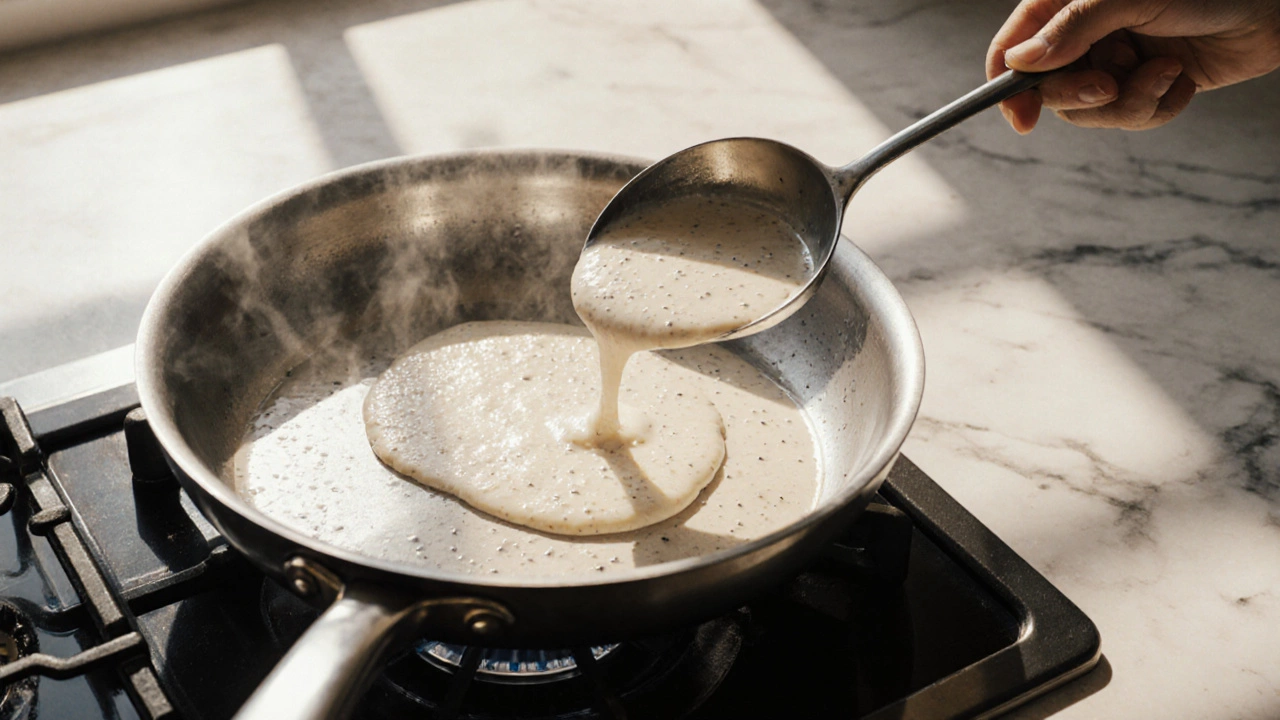Dosa Batter Troubleshooter
Enter your batter preparation details and click "Analyze My Batter" to identify potential issues and solutions.
Ever poured a bowl of batter onto a hot pan only to see a sad, flat pancake instead of the airy, crisp fluffy dosa you were hoping for? You’re not alone. A lot of home cooks run into this problem, and the good news is that most of the reasons are easy to spot and even easier to fix.
Understanding What Dosa Batter Is
When your Dosa batter is a fermented blend of rice and lentils that creates the signature thin, crisp Indian crepe turns out flat, the issue usually lies in the preparation steps before the first sizzle.
Two core ingredients form the backbone of any good batter:
- Urad dal (black gram, the high‑protein legume that adds softness and helps fermentation)
- Parboiled rice (medium‑grain rice that gives structure and crunch)
Both must be treated with care - from soaking to grinding - because they supply the natural sugars that wild yeasts love to turn into tiny bubbles.
Common Reasons Your Batter Stays Flat
Before you jump into the kitchen, let’s run through the usual suspects. Knowing the cause will point you straight to the fix.
| Cause | How It Affects the Batter | Quick Fix |
|---|---|---|
| Wrong rice‑to‑dal ratio | Too much rice makes the mix heavy; too much dal makes it soggy | Stick to 3:1 (rice:dal) by volume |
| Insufficient soaking | Hard grains grind poorly, leaving large particles that hinder fermentation | Soak rice 4‑6hours, dal 6‑8hours (or overnight) |
| Improper grinding | Coarse texture limits airflow; overly fine texture can become glue‑like | Grind to a smooth, slightly grainy paste; add water gradually |
| Wrong fermentation temperature | Cold rooms slow yeast activity; hot rooms over‑ferment and produce sourness | Maintain 77‑86°F (25‑30°C) for 8‑12hours |
| Too little water | Batter stays thick, limiting bubble formation | Aim for a pouring consistency - about 1cup water per cup of dry ingredients |
| Skipping leavening agent | Natural fermentation may not produce enough rise, especially in cooler climates | Add ½tsp baking soda just before cooking |
Getting the Ingredient Ratios Right
The classic South Indian recipe calls for a 3:1 ratio of rice to urad dal. That means for every cup of dal you need three cups of rice. If you’re experimenting with millet, quinoa, or split peas, keep the same proportion in mind - the batter’s structure relies on that balance.
Weight works even better than volume because rice and dal have different densities. A simple kitchen scale will give you consistent results every time.

Soaking and Grinding - The Foundation
Both Urad dal and Parboiled rice need a good soak. The longer the soak, the easier it is to grind a smooth paste and the more fermentable sugars become available.
- Rinse the grains thoroughly to remove dust.
- Soak rice in a bowl of water for 4‑6hours.
- In a separate bowl, soak dal (and a small handful of fenugreek seeds, if you like) for 6‑8hours.
- Drain, then blend the dal first with a splash of fresh water until smooth.
- Add the rice to the grinder, gradually incorporating water until you achieve a slightly grainy, pourable consistency.
- Mix the two pastes together in a large non‑reactive bowl.
Notice the batter should flow easily off a ladle but still hold a faint coating on the spoon - that’s the sweet spot for fermentation.
Mastering Fermentation
Fermentation is where the magic (and the bubbles) happen. It’s a natural process driven by wild yeast and lactic‑acid bacteria present on the grains and in your kitchen air.
Key variables:
- Temperature (the ambient heat that speeds up or slows down microbial activity) - aim for 77‑86°F (25‑30°C).
- Time - typically 8‑12hours in a warm kitchen; longer in cooler places.
- Cover - keep the bowl loosely covered with a clean cloth to allow airflow while preventing dust.
If you live in a chilly city like Wellington, a warm spot can be a turned‑off oven with the light on, a microwavable rice cooker on the “keep warm” setting, or a insulated cooler with a warm water bottle.
Watch for the batter to rise by about a third and develop a light, sour aroma. That’s when it’s ready for the pan.
Water Consistency and Its Impact
Water isn’t just a diluent - it affects gluten formation, bubble retention, and heat transfer during cooking. Adding water too early can thin the batter before fermentation, leading to a weak structure. The safest approach is:
- Grind to a thick paste (about the consistency of a thick smoothie).
- Let it sit for 30minutes; the grains will release more moisture.
- Adjust with water just before you start cooking, aiming for a pourable but slightly clingy texture.
In humid climates you may need less water; in dry places, a splash more.

When (and How) to Use Baking Soda
Natural fermentation often produces enough lift, but if your kitchen stays below 70°F (21°C) the rise can be sluggish. A pinch of baking soda (about ½tsp per 2‑cup batch) added right before you ladle batter onto the pan will give an instant surge of bubbles.
Be careful not to add it too early - that’s why the rule of thumb is “add just before cooking.” Over‑using it makes the dosa taste metallic and can cause the batter to collapse.
Choosing the Right Pan - The Tawa Factor
The classic tawa (a flat, heavy cast‑iron or seasoned steel griddle used for South Indian cooking) heats evenly and retains high temperature, both essential for quick puffing.
If you don’t have a tawa, a non‑stick skillet works, but pre‑heat it well and use a thin layer of oil. A hot surface (around 400°F / 200°C) causes the batter’s surface to set instantly, trapping steam inside - that’s the puff you’re after.
Quick Troubleshooting Checklist
- Did you soak the rice and dal long enough? Yes → Move on.
- Is the batter’s consistency close to a thin pancake batter? No → Add a little water.
- Did you ferment at 77‑86°F for at least 8hours? No → Find a warmer spot and wait.
- Is the batter visibly bubbly and slightly risen? No → Add a pinch of baking soda before cooking.
- Is the pan scorching hot? No → Heat it longer; low heat yields flat dosas.
Follow the first failing item, adjust, and you’ll see a noticeable difference on the next pour.
Frequently Asked Questions
Why does my batter taste sour but still stay flat?
Sourness shows that fermentation happened, but other factors - like low temperature, too‑thick consistency, or insufficient water - can prevent proper puffing. Adjust the water and ensure the pan is hot.
Can I use instant rice instead of parboiled rice?
Instant rice lacks the starch structure needed for fermentation, so the batter will stay dense. Stick to parboiled or regular short‑grain rice for best results.
Is it okay to add yogurt or buttermilk to the batter?
A small amount (1‑2tbsp per cup of batter) can boost acidity and help fermentation, but too much will make the batter runny and affect puffing. Use it sparingly.
My batter ferments overnight but still doesn’t puff; what now?
Try adding a pinch of baking soda right before cooking. Also check that the pan is hot enough - a cold surface will never give a puff, no matter how bubbly the batter is.
Can I refrigerate fermented batter for a week?
Yes, keep the batter in an airtight container in the fridge. It will slow down fermentation, so give it a quick room‑temperature rest (30‑45minutes) before using, and add a tiny pinch of baking soda if it feels dense.
By understanding the science behind each step and tweaking the variables that matter most, you can turn every flat, disappointing batter into a stack of perfectly puffed, golden‑brown dosas. Happy cooking!
